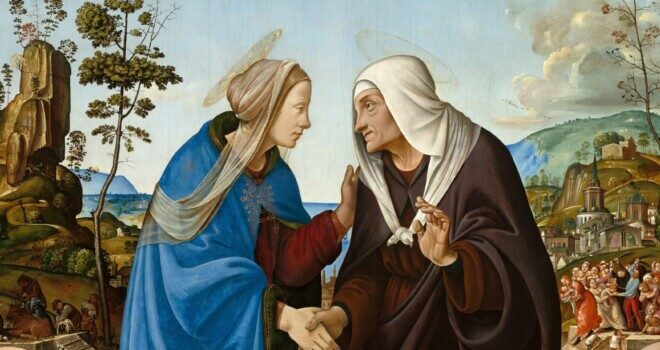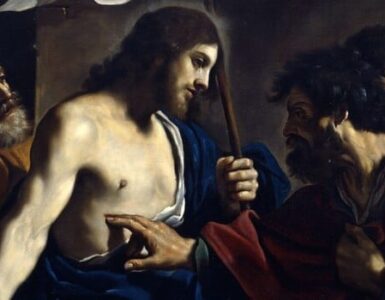Meditating on Piero di Cosimo’s Imaginative Masterpiece
Piero di Cosimo’s Visitation is perhaps the most elaborately imaginative rendering of Mary and Elizabeth’s meeting. The artist, known for his eccentricities, weaves together an array of symbols and scenes, all of which underscore the momentous nature of this joyful encounter. The painting offers much for us to contemplate. (The image from Google Arts and Culture lets you zoom in on all the delightful details.)
In the center of the painting, Mary and Elizabeth gaze at one another with tender reverence, honoring each other’s unborn sons. Mary, who came “in haste” to help the pregnant Elizabeth, compassionately places her hand on her cousin’s shoulder. Bowing, Elizabeth holds her hand up and exclaims, “Blessed are you among women, and blessed is the fruit of your womb! Who am I that the mother of my Lord should come to me” (Luke 1:42)?
In her response, Mary proclaims the coming of the Messiah, “My soul magnifies the Lord, and my spirit rejoices in God my Savior, for he has looked on the humble estate of his servant” (Luke 1:46-47).
Piero paints Elizabeth in plain brown attire and Mary in a red dress and a brilliant blue cloak lined with gold, which signifies her queenship and the divinity within her womb. One striking detail is the translucent, embroidered veil draped over Mary’s head. The contrast between Mary and Elizabeth’s clothing reminds us that even though this is a meeting between friends, it is also the meeting between divinity and humanity.
The handshake, which marks the very center of the painting, draws our attention. This gesture communicates an affection between the friends; however, it is also a sign of a marriage or oath. At the moment John kicks in Elizabeth’s womb, Saint Ambrose says, “The forerunner becomes aware of the pledge of our salvation.” In His mercy and understanding, God makes His pledge known most personally.
An isolated red wallflower, which is said to have grown under the cross from the drops of Christ’s blood, lies in front of the women and symbolizes the divine love that brings them together and that ultimately brings about our salvation.
by Piero Di Cosimo
In the foreground, Saint Nicholas and Saint Anthony frame the painting. Nicholas can be identified by the three gleaming gold balls, which signify the three dowries he gave to an impoverished father with three daughters who wished to marry. Amidst the action of the painting, he studies scripture, reminding us that God calls us to contemplate His word and spend time with scripture despite the distractions of our lives.
Saint Anthony Abbot, a founder of monastic life, can be identified by his cane, bell, and wild pig. He, too, is focused on his writing and contemplation. All four central figures embody an attitude of attentive reverence.
A sea lies directly behind Mary and Elizabeth in the center of the painting, alluding to their future reunion at Jesus’s baptism. At the Jordan River, God transformed the waters from which He brought forth creation into the water of spiritual birth. Through baptism, God gives the gift of adoption and new life in the Holy Spirit. This Theophany, or appearance of God, brings us back to the Visitation, the moment John and Elizabeth are “filled with the Holy Spirit” (Luke 1:41).
On the edges of the painting, Piero paints buildings with scenes from Jesus’s infancy on small, stage-like thresholds. In paintings of the Visitation, buildings often function as a reminder that Mary and Elizabeth’s bodies are themselves dwellings for Jesus and John.
Saint Ambrose calls attention to the concealed activity within their wombs: “The women speak of the grace they have received while the children are active in secret, unfolding the mystery of love with the help of their mothers, who prophesy by the spirit of their sons.” The Visitation reminds us to be attentive to the hiddenness of Christ in the world and in others.
Motifs of life and death surround the central figures. On Elizabeth and John’s side, we see chaotic violence in the massacre of innocents. Herod’s grasping desire for power and self-exaltation ultimately led to murder. Behind the killings is a withered tree. These motifs point to Saint Augustine’s idea of the City of God and the City of Man. The City of Man is marked by death, sin, and love of self.
John the Baptist’s life is inextricably tied to the murdered children. He, too, was hunted in the massacre. Tradition tells us that Elizabeth hid with John in the crypt under their house. Though the Baptist survived the massacre, he follows the innocents in martyrdom.
Sin and death pervade the world Christ came to redeem, but as Mary tells us in her Magnificat, spoken in this scene, Herod and the like do not have the last word, “He has shown strength with his arm; he has scattered the proud in the thoughts of their hearts; he has brought down the mighty from their throne and exalted those of humble estate” (Luke 1:51-53). Though their deaths are tragic, the cross on the Church behind this scene reminds us that the innocent live in Heaven by the power of their Savior.
On the other side of the painting, a small, almost hidden nativity is positioned in front of another building. Love of God marks this Heavenly City, where life is cherished. Close by, a healthy tree grows with fruitful branches in front of a rocky mountaintop. The Magi descend the mountain to pay homage to the infant King.
This mountain alludes to other moments in the life of Christ, namely the Sermon on the Mount and the Transfiguration, when Jesus revealed Himself in another Theophany. Here, the central image reminds us again that a kind of Theophany also occurs at the Visitation, when Jesus reveals Himself to John in the womb.
Mary and Elizabeth’s meeting may seem insignificant when considered against the backdrop of more important events in the life of Christ. Piero’s painting challenges this supposition and reminds us that God brought about His plans for salvation, even in the womb.
From the Visitation, we can remember that Christ wants us to be present to the people he puts in our lives, rejoicing in their blessings and hastening to help them when we can. Mary and Elizabeth rejoice in the great gifts God gives them—most importantly, Jesus.
Di Cosimo, P. (1490). Visitation with Saints Nicholas and Anthony Abbot. [oil on panel]. Retrieved from The National Gallery.











